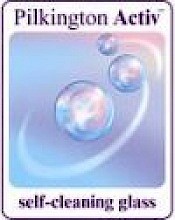Pilkington Activ™ Self Cleaning Glass
Website
Date Added
20 February 2009
Company
Country of Origin
Categories
Subcategories
Supporting Info URL
"Pilkington is one of the world's largest manufacturers of glass and glazing products for building, automotive and related technical markets. They created the first self-cleaning glass, using a nano - thin layer that breaks down dirt and other organic materials and prevents them from sticking to the glass."
In 2001 Pilkington Glass announced the development of the first self-cleaning windows, Pilkington Activ™, and in the following months several other major glass companies released similar products, including PPG's Sunclean™. As a result, glazing is perhaps the largest commercialisation of self-cleaning coatings to date. All of these windows are coated with a thin transparent layer of titanium dioxide (titania or TiO2), a coating which acts to clean the window in sunlight through two distinct properties: photocatalysis causes the coating to chemically break down organic dirt adsorbed onto the window, while hydrophilicity causes water to form ‘sheets’ rather than droplets – contact angles are reduced to very low values in sunlight (the coating becomes ‘super-hydrophilic’), and dirt is washed away. Titania has become the material of choice for self-cleaning windows, and hydrophilic self-cleaning surfaces in general, because of its favourable physical and chemical properties. Not only is titania highly efficient at photocatalysing dirt in sunlight and reaching the super-hydrophilic state, it is also non-toxic, chemically inert in the absence of light, inexpensive, relatively easy to handle and deposit into thin films and is an established household chemical – it is used as a pigment in cosmetics and paint and as a food additive. The latter point may explain the rapid transition of self-cleaning titania surfaces from the research laboratory to the marketplace. The mechanisms of the self-cleaning processes that occur on titania surfaces have been thoroughly investigated over the past decade,16 and although research continues to describe the exact mechanism for the destruction of specific pollutants,17–19 a basic model has gained wide acceptance. A thorough discussion of the theory of photocatalysis and super-hydrophilicity is beyond the scope of this article, hence only a brief summary follows. Greater detail can be found in one of several review articles on the subject.16,20–22 A semiconductor under normal conditions, titanium dioxide absorbs light with energy equal to or greater than its band gap energy, resulting in excited charge carriers: an electron, e−, and a hole, h+ (Fig. 3). Although the fate of most of these charge carriers is rapid recombination, some migrate to the surface. There, holes cause the oxidisation of adsorbed organic molecules while electrons eventually combine with atmospheric oxygen to give the superoxide radical, which quickly attacks nearby organic molecules. The result is a cleaning of the surface by ‘cold combustion’, the conversion of organic molecules to carbon dioxide and water (and other products if heteroatoms are present) at ambient temperatures. This process is remarkably effective and clean; e.g. the total decomposition of stearic acid [CH3(CH2)16CO2H] in the presence of atmospheric oxygen to CO2 and H2O, a 104 electron oxidation, occurs with no detectable by-products on a TiO2 surface (Fig. 4).23 A wide range of solid-, liquid- and gas-phase organic pollutants can be broken down in this way, including aromatics, polymers, dyes and surfactants,16 although a much smaller range of inorganic materials have been successfully decomposed on titania. Photocatalysis is usually tested by monitoring the destruction of a model pollutant. Stearic acid, methylene blue and chlorophenol are popular choices as they are easy to quantitatively measure by spectroscopy. Parkens et al. (2005)
Nanomaterials
Functions of Nanomaterial
How much we know
Related Products (similar nanomaterials and/or categories)
Pilkington Activ™ Self Cleaning Glass
Category: Home and Garden > Construction Materials
Origin: USA
Nanomaterial: Titanium dioxide
How much we know: Category 5 (Not advertised by manufacturer)
Sadolin Facademaling Extra Nanotec
Company: Sadolin
Category: Home and Garden > Construction Materials
Origin: Denmark
Nanomaterial: Titanium dioxide
How much we know: Category 4 (Unsupported claim)


